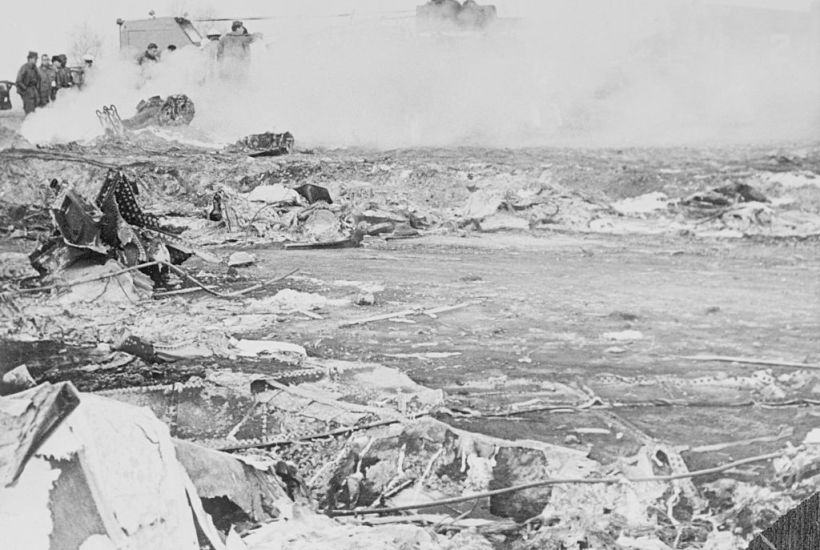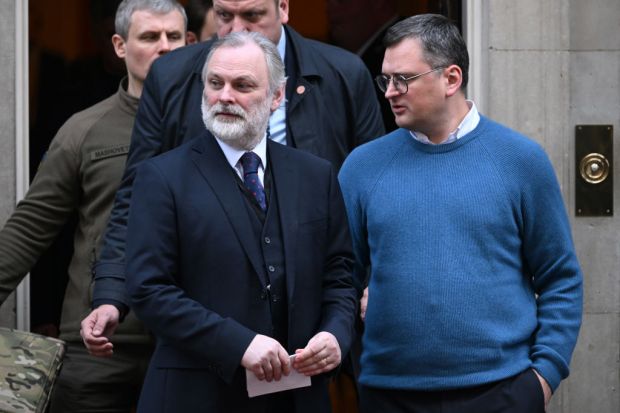On a cold wet day in January 1961, Lt Jack ReVelle climbed out of a muddy hole in the ground, holding a rough, grey sphere the size of a volleyball against his chest. For the better part of a week, he and his crew had been digging in the swampy ground outside of Goldsboro, North Carolina. It had been raining and snowing, and the hole had grown to be larger than a football field. Jack was just 25 years old, but he was in charge. When he and his men finally found what they were looking for, Jack was the one who got to climb up the ladder and bring it out.
Almost immediately, Jack flew back to Wright-Patterson Air Force Base in Dayton, Ohio. He landed in the late afternoon, and went to bed early. The next morning, he took a shower, sat down at a table in his apartment, and started to write a letter to his parents, who hadn’t heard from him for more than a week. It was only then that the magnitude of what he’d done started to set in. His hands started to shake.
Lt Jack ReVelle had just located and defused two nuclear bombs that accidentally fell out of a B-52 bomber over Eastern North Carolina.
It sounds like hyperbole, but the story of the Goldsboro Broken Arrow has now been well documented. Over the last decade, more and more of it has been declassified, thanks in large part to the work of an Air Force veteran named Joel Dobson of Greensboro who first heard the story years ago and just knew he had to write a book about it. I talked to Joel back in 2018, and he put me in touch with Jack. Over the course of a few days, Jack and I traded emails and talked on the phone for hours. He was soft spoken and kind, but also precise. He grumbled about other tellings of the story that had gotten details wrong. He made jokes, including one about how a superior had offhandedly ‘dropped the bomb on me’ by casually relating important information. Our conversation veered from the incredible to the personal, and it left me thinking about the consequences of life and the steady approach of death in a way that has stayed with me ever since.
I traded more emails and made an occasional phone call to him in the year that followed, but then lost touch with him. It was only later that I discovered that he’d died three years ago last month, after fighting a disease that was brought on by a military career of responding to radioactive accidents. That volleyball-sized orb that he’d carried out of that muddy pit in 1961 was the primary core of a hydrogen bomb, with enough uranium and plutonium inside to create a huge crater, kill tens of thousands of people instantly, and leave parts of Eastern North Carolina permanently uninhabitable. The only protection the Air Force gave Jack ReVelle was his military fatigues and a pair of gloves. He held the most radioactive part of the most powerful weapon the world had ever seen up against his chest for 15 minutes. Then, for decades, he couldn’t tell anybody exactly what he’d done, not even his wife. ‘Today, a lot of other people want to claim glory from themselves,’ says Brenda ReVelle, his widow. But Jack knew the real story. ‘Not being able to relay that was really hard,’ Brenda says. By the time he sought recognition and help from the government, it was too late.
On the night of January 23, 1961, a B-52 bomber radioed back to Seymour Johnson Air Force Base in Goldsboro with a problem: it had a fuel leak in one of its wings. As it was coming back in for a landing, the wing broke off. Five of the eight men on board were able to bail out, including Lt Adam Mattocks (who died in 2018). As the plane fell from the sky, it started to break apart, and two thermonuclear bombs on board fell out. In the chaos, several systems on the bombs activated themselves. On one, the parachute deployed, and it drifted down gently to the ground, coming to rest against a tree.
The first bomb, leaning up against a tree (Courtesy: U.S. Air Force)
The other one slammed into the ground at 700 miles per hour, not far from the fiery wreckage of the plane.
Lt Mattocks, who had watched the scene unfold below him as he drifted toward the ground, veered away from the fire. He landed two miles away from the scene, touching down behind a family that had been awoken by the sound and was staring at the glowing sky. He asked that family to drive him back to the Air Force base, 12 miles away. When he arrived at the front gate, his uniform was torn up, his military ID was gone, and he was banged up from his escape. His parachute was still on his back. He told the airmen at the front gate that a B-52 had crashed, but the word hadn’t spread to them yet. Mattocks, a black man, couldn’t prove who he was. So, the airmen arrested him for stealing government property. Shortly afterward, another pilot who recognised Mattocks from flight school vouched for him. Mattocks was released, and his details led the Air Force to the crash site.
That’s when Lt Jack ReVelle got the call, got on a plane in Dayton, Ohio with the rest of his explosive ordnance disposal team, and flew to North Carolina.
Once Jack got there, he quickly went up to the bomb leaning up against a tree, rendered it safe, and had it loaded on the back of a flatbed truck headed for Texas. It was then that he learned there was a second bomb, somewhere beneath a farm field nearby that was strewn with wreckage.
Lt Jack ReVelle had just located and defused two nuclear bombs that accidentally fell out of a B-52 bomber
Jack asked for a long wooden stick, like a broom handle, to poke into the wet ground. The reason: He didn’t want to touch metal with metal, and cause a spark that might cause an explosion. So someone fetched a wooden rod from the back of a truck cab, and ReVelle started feeling around in the muck. Quickly, he knew there was debris down there. After that, he called in the heavy excavators.
The biggest issue was the swampy earth that sat beneath the farm field. The shovels didn’t dig too far down before they hit the shallow water table, which meant water constantly needed to be pumped out of the hole. That hole had to be wide as well as deep, so the recovery effort sprawled out across the field. Locals were largely kept in the dark (although some of them found pieces of the plane and kept them as souvenirs). After a lot of digging, Jack’s crew finally found the explosive part of the bomb, as well as some of the systems that would have armed it. On the eighth day, Jack fished it all out of the muddy water at the bottom of the pit. One of his sergeants found another crucial piece.
‘Lieutenant, we found the arm/safe switch,’ he told Jack.
‘Great,’ Jack said.
‘Not great,’ the sergeant replied. ‘It’s on arm.’
There’s far from a consensus on how close those bombs were to going off. Jack himself couldn’t say. But had one of them exploded, the other one would have as well (the military refers to this as a ‘sympathetic detonation’). Each bomb was 250 times more powerful than the ones that decimated Hiroshima and Nagasaki, and an explosion that large would have permanently altered the geography of the state. Even though it would have been at least 50 miles from the Pamlico Sound lagoon, Jack says the blast would have been powerful enough to create a new ‘Bay of North Carolina.’ There would have been a 17-mile-wide ‘kill zone’ around the blast site. Heavy fallout would have spread as far north as New York.
For years, though, the most harrowing information was kept a secret. The Air Force had acknowledged the incident, but said there was realistically no chance of the bombs going off. And Jack himself couldn’t talk about the details of his involvement. It wasn’t until Joel Dobson called him in 2011 that he realised that documents about the incident had been declassified. It was then that Jack turned to his wife and shared with her the details about what he’d done in North Carolina.
Years ago, on the phone from California, Jack ReVelle told me he was ‘crazy’ as a 25-year-old. He drove a 1959 MGA convertible with a car phone in it, so he’d be reachable in the case of a nuclear accident. (I asked him if the car phone was impressive whenever he went on dates. ‘That goes without saying,’ he told me.) He later met his wife Brenda on a computer dating service in the late 1960s. Jack was different than the other guys she’d met through that service. ‘He was always an up front, honest guy,’ she says.
Brenda knew that he worked with something nuclear in the military, and got a sense of what he’d done when she helped him type up his resume. But for years, she didn’t know exactly what it was. ‘He told me the light version,’ she says. He’d made a promise to the military to keep the details a secret. ‘Jack was a true believer,’ Brenda says. ‘He believed in America. And he believed in his promises.’
Jack had been in the Reserve Officers’ Training Corps when he was at Purdue University. After he graduated with a degree in chemical engineering, he joined the Air Force and became an officer. While he was stationed in Japan, he heard about the explosive ordinance disposal (EOD) unit, thought it was interesting, went through six months of training in Dayton, and then got the job. He responded to several nuclear incidents, including a fire in New Jersey in 1960 that destroyed a nuclear warhead and spread radiation around the base. After he disarmed the bombs in Goldsboro in 1961, Jack was sent to take part in hydrogen bomb testing at Christmas Island in the Pacific Ocean. There, in 1962, he witnessed about two dozen detonations as part of Operation Dominic.
Jack earned the Bronze Star during the Vietnam War, where he was exposed to Agent Orange. He also earned the Joint Service Commendation medal for his work with the Defense Nuclear Agency, and was promoted to Major. But after 11 years in the Air Force, Jack was ready to move on. In 1969, he was honourably discharged, then earned a PhD in Industrial Engineering and Management from Oklahoma State University. He had a career as a consultant statistician, travelled the world, worked for aeronautics company, was an active member of MENSA along with Brenda, and wrote technical books based on his training in engineering and management. He made a home in Orange County, California. Until 12 years ago, he never publicly talked about what he’d done in North Carolina. Then Joel Dobson called, interviewed him, and brought him back to the site of the accident. Jack hadn’t been there in 50 years, but he recognised the tree where the first bomb had once been leaning. That moment made the hairs on the back of Joel’s neck stand up.
Jack started telling others about disarming the bombs. He spoke to groups around the country, including at East Carolina University in 2013. ‘As I carried it up out of that hole,’ he said of carrying the radioactive sphere, ‘I remember thinking, ‘Don’t drop it.’
But by then, Jack had already started to get sick. A few years before, his doctor thought he had anaemia. That didn’t make sense to Jack, who’d always thought of himself to be a healthy, high-energy guy. But the doctor confirmed it, then sent him off for further blood tests. Those tests led his doctors to diagnose him with Myeloid Dysplastic Syndrome (MDS), a precursor to leukaemia. Those same doctors also told him that they felt that the disease was likely caused by Jack’s exposure to radiation.
When I talked to him in 2018, Jack was going in for a blood transfusion every two weeks because his body wasn’t making enough red blood cells. He was also taking expensive prescription medication to control his disease.
After the story was declassified and Jack had his diagnosis, he set out to do two things. The first: to seek official recognition for himself and his men for what they’d done in Goldsboro. The story was out, but the Air Force denied any further recognition or honours, saying that the men were simply doing the job that they’d been assigned to do. In 2014, the Veterans Administration had also denied him further insurance coverage to pay for his treatment because, in their words, there was no direct connection between his exposure to radiation and his sickness. That didn’t seem right, Jack told me. ‘According to all the literature that I have read, the MDS that I have shows itself approximately 50 to 60 years following the radiation exposure,’ he said.
In the meantime, Jack continued to tell his story. In 2018, a Hollywood producer acquired the rights to make Dobson’s book into a Hollywood movie. In January 2019, Jack himself appeared on NPR’s StoryCorps with his daughter Karen to talk about his experience in Goldsboro. Shortly after, he emailed, excitedly, to tell me that he’d recently discovered he had a daughter that he never knew of, born eight months after he’d graduated from Purdue.
Two months later, in March 2019, Jack fell while carrying groceries at his home and broke his hip, and lay there until his wife found him. By then he was 83, and was sent to a skilled nursing care facility, but discharged early even though he wanted to remain there to recover and be treated for his MDS. He couldn’t get himself out of bed, couldn’t move his left arm above his shoulder, and couldn’t take a shower or put on socks without help. The Orange County Register picked up his story, and talked about how lawyers had taken up his case pro bono. ‘I was exposed to radiation,’ Jack told a reporter. ‘There is no other source for the cancer.’
For a while, that was the last time I’d heard anything about Jack. After our last conversation, I’d tried to follow up on a story he’d told me, about a picture that he’d been trying to find for years. Back around 2000, when his story was still classified, Jack was speaking at the Sandia National Laboratories, a government-affiliated facility in New Mexico that performs nuclear research. During some free time, he wandered into a museum that was holding an exhibit about Broken Arrows, the military code name for nuclear mishaps. When he came upon a display about Goldsboro, he froze. There, on the wall, was a picture of Jack climbing up the ladder, with the core of the weapon against his chest. ‘I felt like I was losing control of my bowels,’ he said. ‘Oh my God, it’s documented.’
Later, after his story had gone public, Jack, Joel, and Brenda all tried to track down the picture through phone calls and public records requests, but the photo never turned up. Officials at Sandia also looked on my behalf, but never found it.
It reminded me of the fruitless search that went on after Jack pulled the core out of that muddy hole back in 1961. After he flew back to Ohio, the Air Force remained in that field for months, trying to find another part of the bomb. This portion, called the secondary, was a torpedo-shaped piece of radioactive material that, during detonation, would be shot into the round core of the bomb and make the explosion exponentially bigger. There were no detonators on that particular piece, which meant it couldn’t explode on its own. But military searchers could never find it, determined it posed no threat, and left it there in the ground. The only clue that it’s there is an easement from the Federal Government. It keeps the farmer that owns the land from digging any deeper than five feet around the site where they think the secondary is still buried.
A farm field in Faro, North Carolina, near Goldsboro. A radioactive piece of the nuclear bomb that fell here in 1961 is still buried underneath the ground, but the military was unable to find it. The federal government has maintained that it cannot explode, and isn’t radioactive enough to pose a threat to people above, or the groundwater beneath.
In April 2019, Jack’s pro bono lawyer went before the Board of Veterans Appeals in San Diego to plead his case. But for months after that, nothing happened. Jack had stopped making speeches. The case languished. The Hollywood movie hadn’t been in the news. I’d search for news about him from time to time, but nothing new showed up.
Then, at some point last year, I came across a press release about Jack from the lawyers representing him. ‘In February 2020, the final decision was rendered, granting Dr. ReVelle his benefits,’ it said. It had taken four years of work, and 10 months of waiting after their appeal, but Jack had won. The release went through the process and details of the case, but only in the second-to-last paragraph did it say what had happened to Jack: ‘Unfortunately, Dr. ReVelle passed away on January 26, 2020, just three weeks before the decision was rendered.’
Recently, Jack’s widow Brenda talked to me on the phone from her home in southern California, relating what had happened in her thick British accent. Even after his death, it still took a sternly worded letter from Brenda for the VA to start paying his benefits, she says. The VA never sent her a letter back. One day, around six months after Jack died, the money just started being direct deposited into her bank account.
Jack got weaker and weaker during his final days. At a car show, Brenda needed to hold him up by the shoulders. He’d fall more often, once hitting his head. Hard. After Brenda and Karen realised they could no longer care for him, he was taken to an assisted living facility. On January 26, 2020, a caretaker came into his room. ‘Good morning, Jack,’ she said. She got no response.
He’d died in his sleep.
Jack’s passing didn’t get much attention. But the film about his life and the Goldsboro Broken Arrow is starting to materialise. Brenda is consulting with the producer, who also made the movie Hacksaw Ridge. A script is finished. The director Gavin Hood has signed on to the project. Before long, it seems, the world will become well acquainted with Jack ReVelle.
It’ll be hard for any movie to present him in full. ‘Jack was a very unusual person to live with,’ Brenda says. He was unpredictable. You did what? was a popular phrase around the ReVelle house. ‘He’d always tell me: “We’ve had our ups and downs, but it’s always been interesting,”’ Brenda says. One year, Jack got involved in the Baja Races in Mexico, and somehow ended up as the flagman. Another time, when he was living in Tucson and working for the defence contractor Raytheon, he found out the local soapbox derby had run out of funding. No problem, Jack told the organisers, Raytheon will put up the money. ‘Then,’ Brenda says, chuckling, ‘he had to tell Raytheon.’
Still, for most of his life, Jack lived with secrets that he could tell no one. In the early days, he didn’t get the respect he deserved, Brenda says. Being able to talk about what he’d done, 50 years after he’d done it, lifted a great weight off of his shoulders. ‘It was a relief,’ she says. ‘It gave him a second lease on life.’
This article first appeared in the North Carolina Rabbit Hole.
Got something to add? Join the discussion and comment below.
Get 10 issues for just $10
Subscribe to The Spectator Australia today for the next 10 magazine issues, plus full online access, for just $10.




















Comments
Don't miss out
Join the conversation with other Spectator Australia readers. Subscribe to leave a comment.
SUBSCRIBEAlready a subscriber? Log in